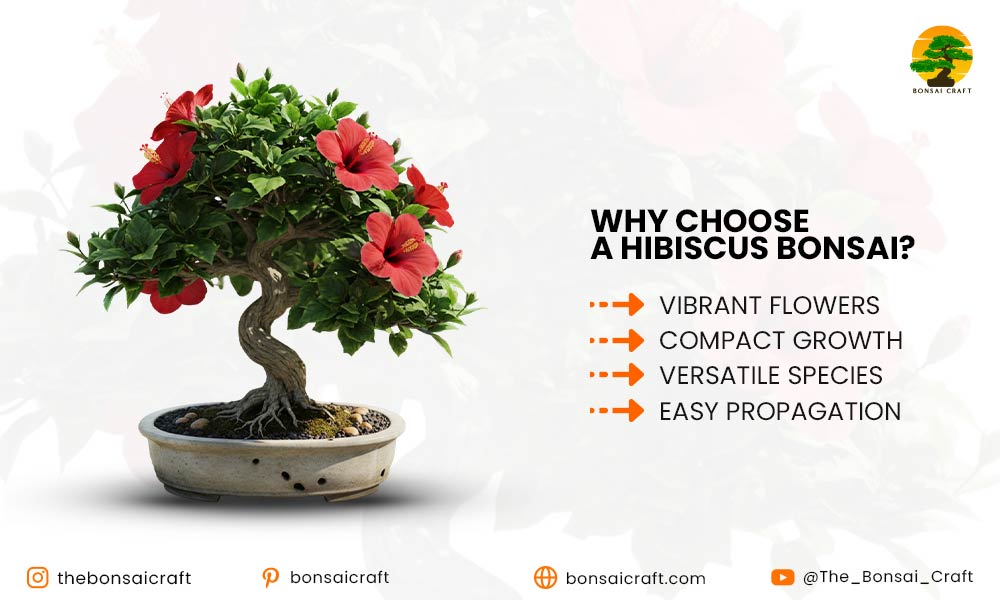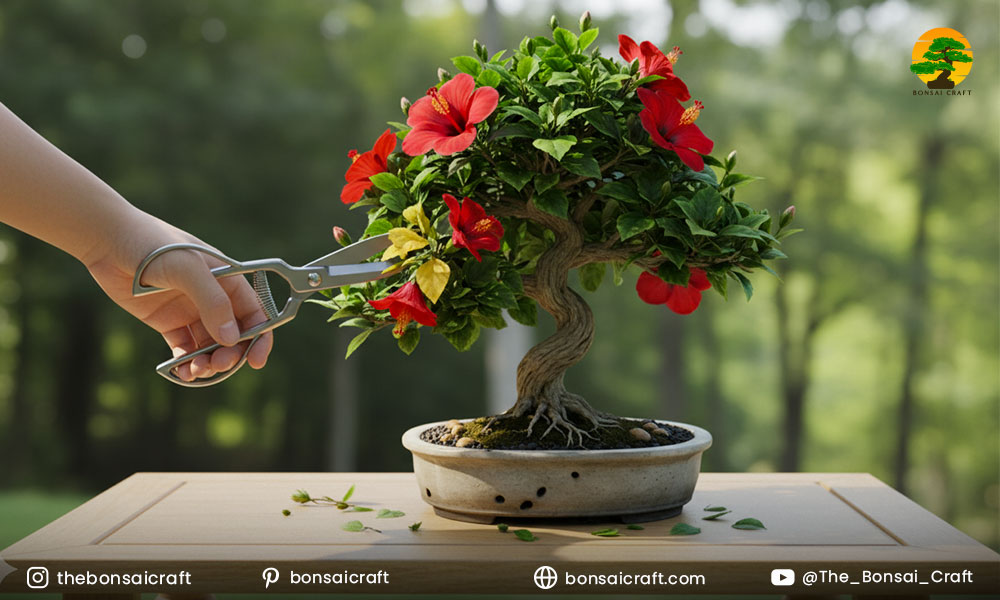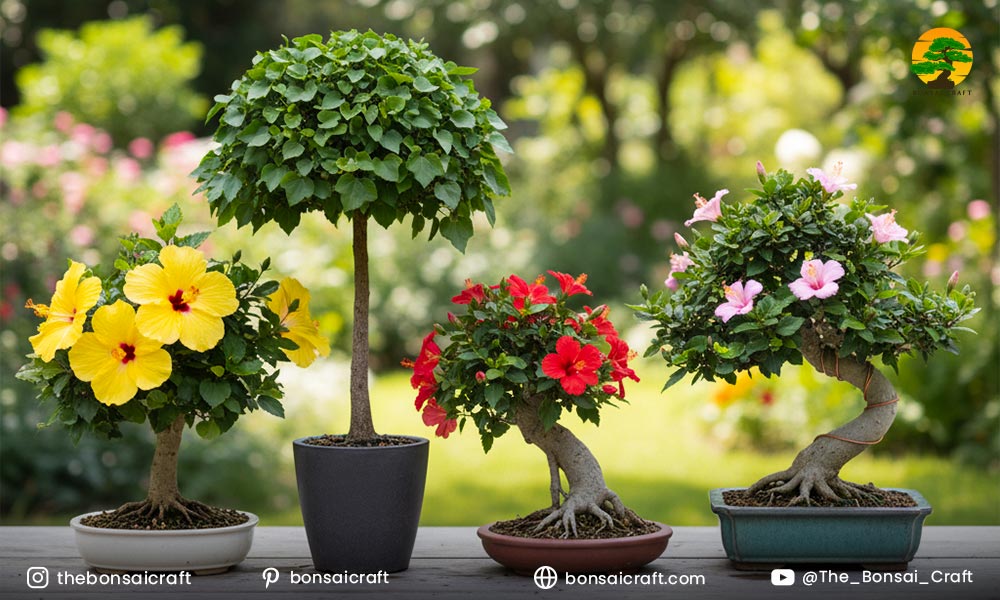
The hibiscus bonsai is a stunning blend of tropical beauty and artistic miniature form. With vibrant blooms and lush foliage, a bonsai hibiscus plant can brighten any space, indoors or outdoors. From sea hibiscus bonsai to cranberry hibiscus bonsai, these trees captivate bonsai enthusiasts with their showy flowers and manageable size.
As a dedicated bonsai grower with years of hands-on experience, I’ve found that mastering hibiscus bonsai care requires understanding the plant’s growth habits, pruning techniques, watering needs, and propagation methods. This guide provides practical, expert advice to help you nurture and shape your hibiscus bonsai tree into a thriving miniature masterpiece.

Why Choose a Hibiscus Bonsai?
Bonsai hibiscus plants are popular due to:
- Vibrant flowers: Hibiscus blooms range from red, pink, yellow, to white, creating eye-catching displays.
- Compact growth: Perfect for container cultivation and small spaces.
- Versatile species: Options like hibiscus tiliaceus bonsai and cranberry hibiscus bonsai adapt to tropical and subtropical climates.
- Easy propagation: Can be grown from cuttings, making it beginner-friendly.
The hibiscus tree bonsai is not just decorative—it’s an opportunity to practice horticultural skills and artistic shaping simultaneously.
Can You Make Hibiscus Bonsai from Cuttings?
Yes, you can make hibiscus bonsai from cutting. Softwood or semi-hardwood cuttings root easily with proper care, offering a quicker start compared to growing from seeds.
Cuttings allow for controlled shaping from an early stage, ensuring your bonsai hibiscus plant develops a strong trunk and desirable branching patterns. Rooting hormone and well-draining soil increase success rates.
How to Make Hibiscus Bonsai
Creating a bonsai hibiscus involves several steps:
- Choose healthy plant material – Healthy cuttings from a young hibiscus tree or healthy hibiscus cuttings- these are the bonsai hibiscus plant materials needed.
- Prune for shape – Trim leaves and branches to spur more compact growth.
- Plant in bonsai soil – To promote adequate drainage, plant in a container with a mixture of 1 part akadama, 1 part pumice, and organic matter.
- Wire branches if needed – If needed, gently shape the branches to your preferred style using bonsai wire.
- Provide sunlight and water – Make sure the soil is evenly moist, and the plant receives bright, direct light.
Patience is key—the flower hibiscus bonsai may take 1–2 years to show substantial growth and flowering.
How to Make Hibiscus Bonsai from Cutting
Step-by-step propagation for bonsai hibiscus:
- Select cutting – Take a 4–6 inch semi-hardwood cutting from a healthy branch.
- Apply rooting hormone – Dip the base in rooting powder to stimulate root growth.
- Plant in soil – Use a well-draining mix, water lightly, and cover with plastic to maintain humidity.
- Place in indirect sunlight – Keep cuttings warm and bright, avoiding harsh direct sun.
- Monitor growth – Roots develop in 4–6 weeks. Transplant to a small bonsai pot once roots are established.
Using this method, you can propagate multiple bonsai hibiscus trees from a single parent plant.
Watering and Sunlight Needs for Hibiscus Bonsai
- Watering: Keep the soil evenly moist but not waterlogged. Water when the top 1–2 inches of soil feel dry. During hot summer months, daily watering may be necessary.
- Sunlight: Hibiscus thrives in bright sunlight. Place your hibiscus bonsai outdoors in filtered light or indoors near a south-facing window. Avoid prolonged shade, which reduces flowering.
- Humidity: Tropical species like hibiscus tiliaceus bonsai prefer higher humidity. Use humidity trays or mist regularly if kept indoors.

Pruning Hibiscus Bonsai
Pruning is crucial for maintaining shape and encouraging flowering:
- Timing: Prune after flowering or during active growth (spring and summer).
- Maintenance pruning: Remove dead or crossing branches.
- Flower pruning: Trim spent blooms to encourage more flowering cycles.
- Leaf pruning: Reduces leaf size and enhances overall aesthetic.
Always use sharp, sterilized scissors or shears to prevent infections in your hibiscus bonsai tree.
Fertilizing Hibiscus Bonsai
Bonsai hibiscus plants require regular feeding for healthy growth and vibrant flowers:
- Type: Use balanced NPK fertilizer (10:10:10) or organic options.
- Schedule: Fertilize every 2–3 weeks during growing season (spring to early autumn).
- Winter care: Reduce feeding in winter dormancy, especially for tropical hibiscus species.
- Liquid fertilizer: Ideal for faster nutrient uptake and during flowering periods.
Consistent fertilization keeps your hibiscus bonsai plant lush and blooming.
Repotting Hibiscus Bonsai
Repot your hibiscus bonsai every 2–3 years to prevent root-binding and replenish soil nutrients:
- Remove the plant from its pot and prune thick or damaged roots.
- Replace old soil with fresh, well-draining bonsai mix.
- Water thoroughly after repotting and protect from direct sun for 1–2 weeks.
Repotting is best done in early spring before the active growth season begins.

Styling Ideas for Hibiscus Bonsai
Hibiscus bonsai can be shaped in several appealing forms:
- Informal upright (Moyogi) – Natural, flowing trunk with asymmetrical branching.
- Slanting style (Shakan) – Trunk leans to one side for dramatic effect.
- Broom style (Hokidachi) – Ideal for species with upright branches, like sea hibiscus bonsai.
- Flower-focused style – Prioritize bloom visibility over trunk symmetry for flower hibiscus bonsai.
Wiring should be gentle, as hibiscus branches can be brittle, especially in older plants.
Common Problems and Solutions
Even hardy bonsai hibiscus plants face occasional issues:
- Pests: Aphids, spider mites, and mealybugs can affect the foliage. Treat with insecticidal soap or with neem oil.
- Diseases: In overly wet conditions, fungus can set in. Make sure the plant is not in a saucer of water and that there is good airflow.
- Leaf drop: Often caused by sudden temperature changes or in a state of overwatering.
- Flower drop: Happens if the plant lacks light or the fertilizer is too weak. Also caused by stress from pruning.
Regular monitoring and preventive care keep your hibiscus bonsai tree healthy and thriving.
Conclusion
With its tropical style and wide variety of hibiscus bonsai for sale, from the cranberry hibiscus bonsai and the hibiscus tiliaceus bonsai, all offering vibrant and compact blooms, this delightful and stimulating plant adds to an existing collection.
Mastering hibiscus bonsai care involves:
- Correct watering and sunlight attracting
- Constantly scheduled pruning and care
- Timely fertilization
- Repotting every 2–3 years
- Gentle wiring and styling
As an experienced bonsai grower, my tip is to focus on patience and observation. Hibiscus bonsai trees thrive with consistent care, and watching them bloom is a deeply rewarding experience. By following this guide, your bonsai hibiscus plant will flourish and become a miniature tropical masterpiece.
FAQs on Hibiscus Bonsai
How to make hibiscus bonsai from cutting?
To make a hibiscus bonsai from cutting, take a 4–6 inch semi-hardwood cutting, apply rooting hormone, plant in well-draining soil, and maintain high humidity until roots develop.
Can hibiscus grow as a bonsai?
Yes, bonsai hibiscus plants adapt well to container cultivation. With proper pruning, sunlight, and watering, both flower hibiscus bonsai and tropical species like sea hibiscus bonsai can thrive.
How often should I water a hibiscus bonsai tree?
Only water your hibiscus bonsai tree when the top 1-2 inches of the surface soil are dry. More watering is required when it gets very hot but in the winter, the flow of water is slower.
When should I prune my hibiscus bonsai?
Prune after flowering or during active growth in spring and summer. Remove dead branches, trim spent blooms, and shape the tree for compact, healthy growth.
How to fertilize a hibiscus bonsai plant?
Use balanced or organic fertilizer every 2–3 weeks during the growing season. Liquid fertilizers work well during flowering, while feeding is reduced in winter dormancy.
